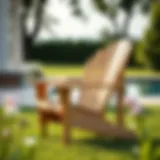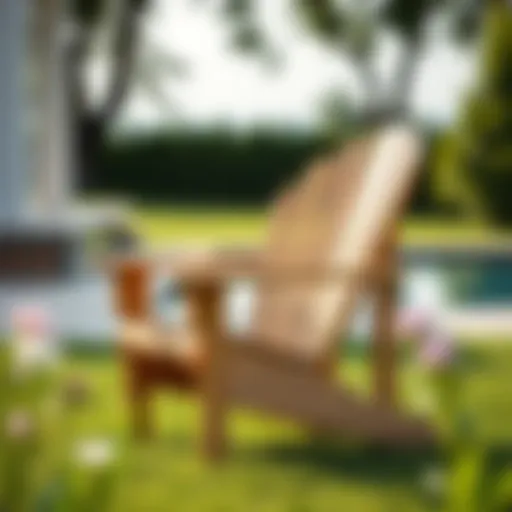Outdoor Seating Guide: Styles and Considerations


Intro
Creating an inviting outdoor space is not just about having a patch of green or a patio slab; it involves crafting an environment that is both functional and aesthetically pleasing. Thinking about how you want to utilize that space can lead to a richer experience outside. After all, outdoor seating can transform a backyard into a cozy retreat or a rigid courtyard into a lively gathering spot.
This guide delves into the diverse world of outdoor seating options. From benches that evoke nostalgia to sleek lounge chairs that showcase modern design, we'll cover the various styles, materials, and practical considerations crucial for homeowners and design enthusiasts alike. Whether you’re sipping coffee in the morning sun or hosting friends for a barbecue, choosing the right seating can make all the difference in your outdoor living experience.
We’ll also touch on essential factors like durability and weather resistance, which are paramount when selecting outdoor furnishings. With so many choices available today, this guide will help you navigate through the multitude of options and highlight the trends redefining our outdoor spaces. So, let’s roll up our sleeves and dive into the vibrant landscape of outdoor seating.
Understanding Outdoor Seating
Outdoor seating isn't just about dropping a couple of chairs on the patio and calling it a day. It's a vital piece of the puzzle when designing a functional and appealing outdoor space. This section delves into what outdoor seating means and why it matters.
Defining Outdoor Seating
Outdoor seating refers to any piece of furniture designed specifically for outdoor use. This includes dining sets, lounge chairs, benches, and more. Unlike indoor furniture, these pieces are often made from sturdy materials like weather-resistant wood or metals, ensuring they can withstand the elements.
When thinking of outdoor seating, it's more than what meets the eye. It's about creating inviting spaces— where family gathers for meals or friends converse over coffee. Outdoor seating invites people to connect with nature while enjoying the comfort of being home. It's a blank canvas for designing spaces that reflect personal style while catering to the needs of daily life.
Importance of Outdoor Spaces
Outdoor spaces extend our living environments. They offer a retreat from everyday routines and an opportunity to bask in sunshine or enjoy a breeze. So, why is that crucial? Here are a few reasons:
- Mental Health: Being outside can work wonders for mental well-being. Having well-designed seating encourages people to spend more time outdoors, which is known to reduce stress and improve mood.
- Social Interaction: Whether for gatherings or weekend barbecues, good outdoor seating can facilitate social interaction, helping build relationships in communities.
- Aesthetic Appeal: An outdoor space with well-selected seating enriches the property's overall look. It's not just about function; it's a chance to express style.
- Boost Property Value: Homes with functional and attractive outdoor seating areas often attract buyers, potentially increasing property value.
Ultimately, outdoor spaces have the potential to enhance our quality of life. They bridge the gap between indoor environments and the outside world, inviting us to enjoy a little slice of nature without leaving home.
"The outdoor space is an extension of the home, where life slows down, laughter resonates, and every moment becomes a memory."
In summary, outdoor seating is integral to thoughtful outdoor space design. It not only adds functionality but creates places for relaxation, socialization, and inspiration, making it a focal point for any home.
Types of Outdoor Seating
When it comes to outdoor environments, the type of seating you choose can make or break the space. Think of outdoor seating as the building blocks of your exterior design. It’s not just about style; it’s about creating a welcoming area for relaxation, socializing, or even dining al fresco. Understanding the different types of outdoor seating allows you to maximize functionality while enhancing the aesthetic appeal of your surroundings. Each type caters to specific needs and occasions, ensuring that your outdoor space serves its purpose to the fullest.
Dining Sets
Dining sets are the heart of outdoor entertaining. They invite friends and family to gather for meals, drinks, and laughter under the open sky. When selecting a dining set, consider the size of your outdoor area and the number of people you typically host. A round table may suit a smaller space, while a rectangular one can accommodate larger gatherings with ease.
The materials play a vital role in durability and aesthetics. For instance, a teak dining set brings warmth and elegance; it naturally weathers beautifully, allowing for a rustic charm over time. Additionally, consider a set with extendable features, offering versatility whether it’s a casual breakfast or a formal dinner party.
Here are some key points regarding dining sets:
- Shape: Round, square, rectangular, and oval options can change the feel of your space.
- Material: Teak, aluminum, and wicker can all provide different vibes and durability ranges.
- Seating Capacity: Match your dining set to your hosting style, considering chairs and benches to suit larger groups.
Lounge Chairs
Lounge chairs are the ultimate call for relaxation outdoors. They can transform a simple patio into a serene escape, perfect for sunbathing or curling up with a good book. Choosing comfortable lounge chairs can mean the difference between merely being outside and truly enjoying your surroundings. Look for designs that offer ergonomic support and cozy cushions.
A popular choice among homeowners are chaise lounges, which provide extended seating for those lazy afternoons. On the other hand, oversized club chairs can make a bold statement while supporting multiple sitters. When considering lounge chairs, think about your personal taste, color schemes, and how they fit into the overall layout of your outdoor area.
Benches and Settees
Benches and settees are timeless seating solutions that often serve multiple purposes. With a solid bench, you create a cozy nook for conversation or a scenic spot to gaze at the sunset. They can be a focal point in gardens, flanking paths or nestled under trees. Plus, many come with storage options hidden beneath the seats, providing a clever way to stow away cushions or outdoor accessories.
Settees may offer extra comfort with cushioned seating, making them well-suited for lounging in style. They can also emphasize traditional aesthetics, appearing in classic wrought iron designs or rustic wooden finishes. Consider the placement of these pieces; their versatility allows you to use them against walls, alongside dining sets, or even in garden spaces where they can complement other flora and fauna.
Swing Seats
Nothing quite matches the charm of a swing seat. Whether it’s hanging from a porch or nestled in a backyard nook, these pieces evoke nostalgia and joy. Swing seats invite playful moments and lazy afternoons spent swaying gently in the breeze. They come in various styles, from minimalist designs made of metal to intricate wooden formats that offer personality.
The key to swing seats is ensuring they’re securely mounted and able to support weight adequately. They can be standalone pieces or part of larger sets, making them adaptable to both modern and traditional designs. Don’t forget to add cushions for comfort, making it an inviting option for anyone seeking respite.
Daybeds and sofas
Daybeds and outdoor sofas create an inviting atmosphere, providing ample seating while offering the luxury of lounging. These are particularly popular in expansive outdoor areas or poolside setups where versatility is vital. A daybed can serve as a sunning space during the day and transition to a cozy gathering spot in the evening. Opt for a design that complements the outdoor landscape, utilizing weather-resistant fabrics and materials that withstand time and climate.
Moreover, consider sectional sofas that allow for the configuration you desire, catering to both small and grand spaces. They can easily accommodate larger groups while maintaining a sense of intimacy. By providing a plush area to unwind in the fresh air, daybeds and sofas elevate the entire outdoor experience.
In summary, when selecting types of outdoor seating, one must consider not only style and aesthetics but also functionality and the intended use of the space. From dining sets to lounge chairs, each seating type serves a unique purpose, setting the tone for the outdoor environment and enhancing the overall enjoyment of your external living space.
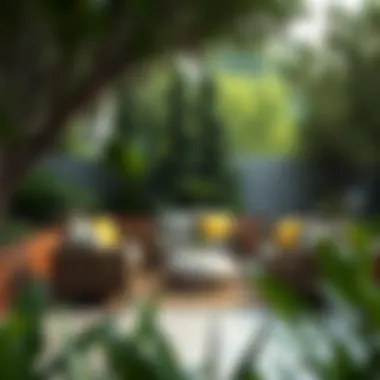

Materials for Outdoor Seating
When embarking on the journey to create or enhance outdoor spaces, the choice of materials becomes crucial. Outdoor seating should not only be functional but also withstand the test of time, weather, and changing tastes. The materials you choose can significantly influence durability, comfort, and aesthetic appeal, ultimately affecting your outdoor experience. Well-selected materials also provide sustainability benefits, aligning with eco-conscious practices important in today’s society. Below, we'll delve into commonly used materials in outdoor seating and their contributions to creating perfect outdoor environments.
Wood
Wood remains a classic choice for outdoor seating. Its natural beauty lends charm and warmth to any space. However, not all wood types are equal, and understanding the characteristics of specific woods can help in making informed decisions.
Teak
Teak stands out in the world of outdoor furniture. Known for its exceptional resistance to decay and moisture, it’s often the go-to wood for patio sets. The high oil content in teak wood makes it a popular choice as it helps to repel water, allowing it to endure harsh weather conditions without deteriorating.
One unique feature of teak is its beautiful aging process; over time, it develops a rich silver patina, enhancing its aesthetic appeal. However, teak can be on the pricier side, which is something to consider if you're working within a budget. Still, homeowners looking for durability paired with luxury often find it worthwhile to invest in this wood.
Cedar
Cedar is another esteemed option, known for its natural resistance to insects and moisture. It imparts a pleasant aroma that many people appreciate. Its light weight makes it easier to rearrange compared to heavier woods.
The key characteristic of cedar is its soft surface, allowing for a more comfortable seating experience without the need for additional cushioning. Even though cedar may not last as long as teak, its affordability and charming rustic look make it attractive for casual outdoor settings. Also, treated cedar can withstand outdoor elements better, but regular maintenance is necessary to preserve its appearance.
Pressure-treated lumber
Pressure-treated lumber is an economical alternative, commonly used for outdoor projects. This type of wood is infused with preservatives to prevent rot and pests, making it a practical choice for budget-conscious homeowners.
While pressure-treated lumber may not possess the rich aesthetic quality of teak or cedar, it can be painted or stained to suit any design style. Just note that it usually requires regular maintenance to keep it looking fresh or to prevent splinters from occurring. The durability of this material, when maintained properly, can deliver years of outdoor enjoyment.
Metal
Metal offers a modern and versatile approach to outdoor seating that appeals to many. This category encompasses various types, each with distinct advantages.
Aluminum
Aluminum furniture is lightweight, making it easy to move and rearrange. An appealing aspect of aluminum is its rust-resistant properties, especially when powder-coated, allowing it to withstand the outdoors without suffering from degradation.
This type of metal can be molded into various designs, from sleek to ornate, making it suitable for many aesthetics. On the downside, uncoated aluminum can become hot in direct sunlight, which could deter some individuals from lounging comfortably in warmer climates.
Steel
Steel, particularly galvanized steel, brings strength and stability to outdoor seating, standing up to heavy use and rough weather. It has a more industrial appeal that resonates with contemporary designs, and it's often used in park benches and commercial areas.
While it provides the durability needed, steel can rust if not properly treated or maintained. Thus, those choosing steel must weigh its sturdiness against the need for maintenance to prevent deterioration over time.
Wrought iron
Wrought iron has long been synonymous with elegance in outdoor settings, often found in classic designs and intricate patterns. Its substantial weight provides stability, making it less prone to shifting in windy conditions.
While wrought iron furniture can last a lifetime if cared for, it is subject to rust if not protected properly. Covering it or applying a weather-resistant finish can greatly extend its life, making it a worthwhile investment for those who appreciate aesthetic detail in their outdoor arrangements.
Plastic and Synthetic Materials
As outdoor design trends evolve, the use of plastic and synthetic materials has gained traction. Though some may view these materials as less desirable, they have unique advantages worth considering.
Resin
Resin furniture is specifically crafted to resist moisture and UV exposure, making it a practical choice for outdoor use. Its lightweight nature allows for easy transport and rearrangement, which can simplify changing your seating arrangement based on your mood.
A standout trait of resin is its ability to mimic the look of natural materials like wood or wicker while providing the convenience of low maintenance. However, cheaper options may fade or wear over time, so choosing quality resin products that can endure various weather conditions is vital.
Polyethylene
Polyethylene is frequently utilized in the manufacture of durable outdoor furniture. This plastic material is designed to withstand exposure to sun and rain without losing its integrity or appealing appearance, making it a reliable option for outdoor settings.
One notable point about polyethylene furniture is its resistance to staining and fading, ensuring that your seating looks newer for longer. However, not all polyethylene is created equal; lower-grade options may not offer the same level of durability compared to higher-end selections.
Recycled plastics
In an age where sustainability is a touchstone for many consumers, recycled plastics have emerged as a commendable choice for outdoor seating. Made from post-consumer waste, this material helps divert plastic from landfills while providing a strong and resilient product.
Recycled plastics can emulate wood or other materials while requiring minimal upkeep, as they resist moisture, insects, and decay. However, a potential drawback is that colors may become dulled over time due to sun exposure, but this can be mitigated through regular care.
By understanding the various materials available for outdoor seating, homeowners and designers can make informed decisions that align with their preferences and needs, ensuring comfort, durability, and style in their outdoor environments.
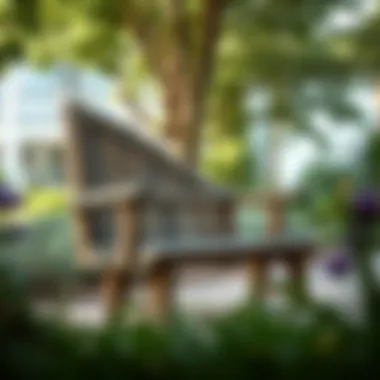
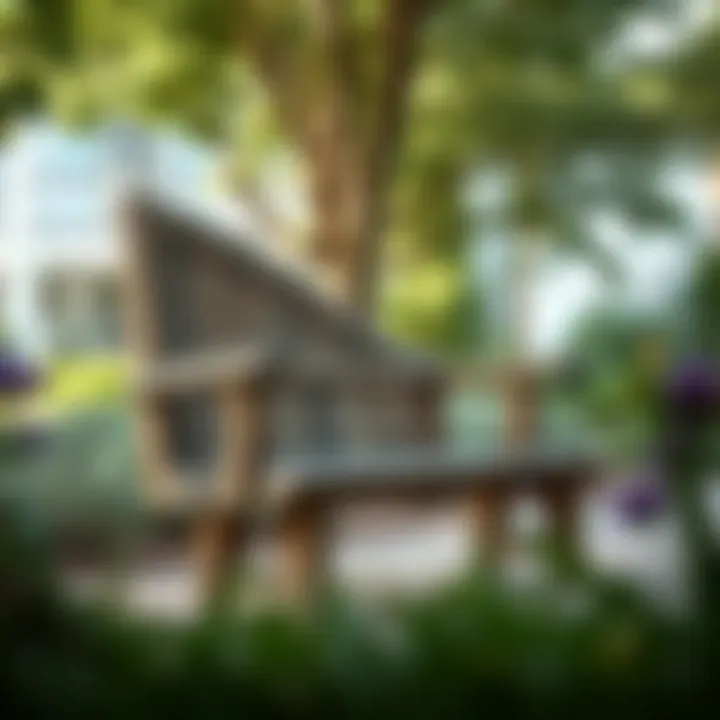
Choosing the Right Style
When it comes to outdoor seating, selecting the right style is more than just a matter of aesthetics. It’s about crafting an environment that reflects personal taste, meets functional needs, and harmonizes with the overall outdoor space. The style you choose not only enhances the visual appeal but also influences comfort, usability, and even the longevity of your furniture. While it might seem straightforward, the impact of style runs deeper than the surface, intertwining with factors like weather resistance, maintenance ease, and the intended purpose of the space.
It’s crucial to consider the surrounding architecture and landscaping when deciding on a style. An eclectic mix can give a charming, lived-in feel, while a uniform selection can create a sleek, cohesive look. Remember, this isn’t about fitting a mold; it’s about expressing individuality in a way that feels comfortable and inviting.
Contemporary Designs
Contemporary outdoor seating often features clean lines and minimal ornamentation, embodying what many see as modern elegance. This style embraces a variety of materials but is particularly known for its use of metals and synthetic materials offering both durability and style. Surfaces are frequently smooth, and colors typically lean towards neutrals or monochromes, which can be easily accessorized with vibrant cushions or throws for a pop of color.
Benefits of Contemporary Designs:
- Timelessness: These designs can transcend trends, making them a good investment for outdoor spaces.
- Flexibility: They can blend seamlessly into various outdoor settings, from urban balconies to spacious yards.
- Maintenance: Often easier to clean, more resistant to wear and tear, thus requiring less upkeep.
Traditional Aesthetics
In contrast to the sleekness of contemporary styles, traditional outdoor seating exudes warmth and familiarity. Featuring ornate details, classic materials like wood, and intricate craftsmanship, this style resonates with timeless charm. Think of finely crafted wooden benches that remind one of sunlit gardens or classic wrought iron chairs that call to mind summer evenings on the patio.
Key Considerations:
- Cultural Influence: Many pieces reflect regional styles, connecting the furniture with cultural narratives.
- Comfort and Cohesion: Often cushioned and designed for lingering conversations, these styles invite long, relaxed gatherings.
- Durability: While aesthetically pleasing, the right materials can withstand the test of time if properly maintained.
Rustic Options
Rustic outdoor seating embraces a more organic aesthetic, emphasizing raw materials and a handcrafted feel. This style often incorporates reclaimed woods, logs, and stones, creating pieces that are as much about nature as they are about function. This productive embrace of nature is both pleasing to the eye and sustainable at its core.
Advantages of Rustic Options:
- Natural Appeal: They blend beautifully into outdoor environments, celebrating the natural surroundings.
- Unique Character: Each piece retains individual characteristics, telling a story through its design and materials.
- Comfortable informality: They often lend themselves to a relaxed atmosphere, encouraging guests to unwind and enjoy the outdoors.
Minimalist Choices
Minimalism in outdoor seating champions the "less is more" philosophy. Stripped of unnecessary embellishments, minimalist designs prioritize functionality and simplicity. Furniture pieces are usually designed with a focus on utility, ensuring each item serves a defined purpose. Whether it’s a clean-lined bench or sleek folding chairs, these choices can maximize small outdoor areas while remaining visually appealing.
Benefits of Minimalist Choices:
- Space Efficiency: Ideal for small patios or balconies, creating an uncluttered feel.
- Easy Integration: These styles can complement various decorative elements, allowing flexibility in design.
- Timelessness: As trends come and go, minimalist choices tend to remain relevant, preserving your investment.
Ultimately, the right style should resonate with your personality while ensuring functionality in your outdoor seating arrangements. Reflecting on these distinct styles can aid in making an informed decision, matching the essence of your space with personal taste.
Practical Considerations
When it comes to outdoor seating, practicality often takes the front seat, overshadowing mere aesthetics. After all, what good is a beautifully designed piece of furniture if it cannot withstand the elements or fits poorly into your outdoor environment? This section outlines critical factors that can make a world of difference in your outdoor seating arrangements, ensuring that your choices both look good and work well over time.
Weather Resistance
Weather resistance is a non-negotiable aspect of outdoor seating. The truth is, your furniture will be exposed to a myriad of weather conditions—from the blistering sun to relentless rain or even unexpected snowfall. Each type of material has its quirks when it comes to durability. For instance, metals like aluminum often resist rusting, making them suitable for coastal areas where salty air might otherwise corrode materials. On the other hand, materials like pressure-treated lumber can endure wet conditions but may need regular sealing to maintain their integrity.
"Choosing weather-resistant options is not just about longevity— it’s about ensuring the seating remains a source of comfort and utility year-round."
So, while selecting your outdoor seating, consider the specific climate of your area. Purchasing covers is a smart way to extend the life of your furniture and protect it when not in use.
Maintenance Requirements
Maintenance of outdoor seating is often overlooked but is crucial for preserving the quality and appearance of your furniture. Whether you choose metal, wood, or synthetic materials, each comes with its own set of maintenance needs.
- Wooden furniture often requires regular treating with oil or sealants to protect against moisture and pests. You can do this annually or biannually, especially before the rainy season.
- Metal options need cleaning to remove dirt and corrosion. Stainless steel may be more forgiving but still requires the occasional polish to keep it gleaming.
- Synthetic materials can often be hosed down for cleaning, but it’s wise to check for specific cleaning recommendations to avoid damaging the surface.
An easy maintenance routine ensures that your outdoor space continues to look inviting, minimizing the hassle down the line.
Space Planning
Space planning is all about ensuring that your outdoor area is not just functional but feels harmonious. The layout should encourage conversation and relaxation while navigating around it remains effortless. A good rule of thumb is to allow at least three feet of space between furnishings; this ensures that guests can move around without feeling cramped.
When mapping out your space, think about how you use it:
- Will it be mainly for dining, lounging, or both?
- Are there natural focal points, such as a fire pit or garden, that should influence your arrangement?
- How many people do you intend to accommodate?
By addressing these considerations upfront, you can create a thoughtful layout that serves your lifestyle while enhancing the aesthetic appeal of your outdoor space.


In summary, practical considerations in outdoor seating are more than just functional. They intertwine design with usability, ensuring that your choices make sense amidst your unique settings and conditions. So, the next time you're selecting furniture for your patio or garden, keep these factors at the forefront of your decision-making process.
Enhancing Comfort
Creating an inviting outdoor space hinges significantly on comfort. When we think about outdoor seating, it's not just about having a place to plop down; it’s about feeling at ease and enjoying the fresh air either with wonderful company or some peaceful solitude. Enhancing comfort involves careful consideration of several elements, including cushions, fabrics, and shade. A well-thought-out seating arrangement can transform a mundane patio into a cozy retreat.
Cushions and Fabrics
One of the simplest yet most effective ways to increase the comfort level of outdoor furniture is by incorporating cushions. Cushions provide support, cushioning and can really make or break your seating experience. Here’s what to consider:
- Material: Opt for fabrics that are durable yet soft. Look for weather-resistant materials like solution-dyed acrylics or polyester blends. These types of fabrics resist fading from sunlight and repel moisture, ensuring long-lasting comfort.
- Thickness: If you want comfort that rivals your living room sofa, go for thicker cushions. Standard seat cushions may suffice, but thicker options give that plush feel that invites you to linger longer.
- Design and Color: Consider the aesthetics as well. Striking colors or patterns can breathe life into your outdoor area while coordinating with your existing decor. Also consider how these colors might wear outdoors; sometimes bright hues can fade under intense sunlight.
Overall, the right choice of cushions can turn hard, uninviting seating into cozy havens where friends and family can gather.
Canopies and Shade Options
While comfort can often center around how soft your seating is, another pivotal aspect is protection from the elements. Canopies and shade options have the dual purpose of making seating areas more comfortable and extending your outdoor enjoyment throughout the day.
- Umbrellas: A market umbrella is an easy-to-setup solution for shaded seating. They come in various sizes and designs. Having one or a couple strategically placed not only adds visual interest but can drastically lower temperatures in hot weather.
- Pergolas: A pergola creates an architectural element in your outdoor space. You can choose whether to leave it open to the sun or hang fabric to provide shade, making it versatile.
- Retractable Awnings: If you want something sleek and more permanent, consider a retractable awning. It allows you to control how much sun you let in while also protecting your furniture from UV damage.
"A shaded seating area can significantly increase the usability of your outdoor space, turning it into a year-round retreat."
In summary, prioritizing comfort involves a multi-faceted approach. By choosing the right cushioning materials and effective shade options, homeowners can create inviting outdoor environments that encourage relaxation and socialization. These elements not only enhance the aesthetic appeal of your space but also ensure that your outdoor seating remains a sanctuary of comfort, backed by practical choices.
Sustainability in Outdoor Seating
Sustainability has become a cornerstone of modern design, affecting how we think about outdoor spaces, including where and how we sit. Recognizing this importance ensures that our outdoor seating choices not only serve us today but also consider the needs of tomorrow. Implementing sustainable principles in outdoor seating fosters a more responsible approach, allowing us to enjoy nature without compromising its health. By making informed decisions about the materials we choose and how we manage those resources, we can enhance our outdoor environments while treading lightly on the planet.
The growing consumer preference for eco-friendly options springs from a desire to minimize our ecological footprint. Homeowners and designers alike are now considering how production processes, material sourcing, and end-of-life disposal impact the environment. Not just a passing trend, sustainability speaks to a shift in mindset that embraces long-term thinking when it comes to outdoor furniture.
Eco-Friendly Materials
Not all materials are created equal when it comes to environmental impact, and eco-friendly materials have emerged as a clear front-runner for sustainable outdoor seating. Let’s break down some notable options:
- Bamboo: Fast-growing and renewable, bamboo provides a durable alternative to traditional woods. It requires less water and no pesticides, making it indeed a standout.
- Recycled Metal: Options like recycled aluminum not only reduce landfill waste but also often require less energy to manufacture compared to new metal.
- Natural Fiber Fabrics: Materials such as organic cotton or hemp are free from harmful chemicals and help in reducing the environmental burden of conventional textiles.
- Composite Materials: Often made from recycled plastics and wood fibers, these materials can provide longevity and resistance to weather while being more sustainable than virgin materials.
Using these materials doesn't just lessen environmental impact; it can also enhance the aesthetic appeal of outdoor spaces. They embody a uniqueness that mass-produced options rarely achieve, offering character while benefiting the planet.
Recycling and Reusing
In the age of throwaway culture, recycling and reusing have become vital practices. These concepts are particularly relevant when it comes to outdoor seating. By opting to refurbish or repurpose existing furniture, homeowners can save resources and reduce waste. Here’s how:
"Recycling transforms used materials into new products, while reusing extends the life of an item without processing."
- Upcycling: Transforming old wooden pallets into stunning benches or tables can breathe new life into neglected items that might otherwise end up in the garbage.
- Repurposing Fabric: Old cushions or drapes can be stylishly altered into seat covers or decorative throws, adding a unique touch to outdoor furniture.
- Sourcing Second-Hand Furniture: Not all second-hand options are outdated. Vintage finds can add character and charm to your patio, offering both sustainability and style.
Incorporating recycling and reusing into your outdoor seating not only minimizes waste but also invites creativity into your space. This way, every piece tells a story—a nod to the past while serving the future. Moving forward, an awareness of sustainability will be crucial for every homeowner and designer looking to create lasting, responsible outdoor spaces.
Future Trends in Outdoor Seating
The world of outdoor seating is evolving at breakneck speed, hopping on trends that cater for not only style but also sustainability and functionality. Understanding these future trends is crucial for homeowners, designers, and enthusiasts alike. For one, keeping up with trends means you can ensure your outdoor space remains relevant and appealing. These trends often reflect social changes and technological advancements, leading to designs that are not just visually striking but also enhance the user experience.
Innovative Designs
Today's outdoor seating designs push the boundaries of creativity and function. One major trend is the integration of modular seating. These sets can be rearranged to accommodate everything from intimate gatherings to bustling BBQs. They stand out with versatile configurations that allow for personal expression. People often enjoy crafting spaces that meet their shifting needs and moods.
Additionally, nature-inspired geometry plays a significant role in upcoming styles. Think of organic shapes and patterns that mimic the curves found in the environment, creating a seamless blend between furniture and nature. Materials like wood and stone are increasingly getting a modern twist, showing up in sleek, minimalist outlines that still honor traditional craftsmanship.
Here are a few points about what makes innovative designs stand out:
- Customization: Furniture that can be tailored to specific aesthetics or environments, making each piece unique to the owner.
- Space Optimization: Lightweight options that can be easily relocated for those who value flexibility in their outdoor setups.
- Sustainability: Using environmentally-friendly materials, such as reclaimed wood or recycled metals, aligns with eco-conscious consumer preferences.
Smart Outdoor Furniture
Moving beyond aesthetics, smart outdoor furniture now plays a role in improving convenience and comfort. Imagine lounge chairs that have built-in speakers or tables equipped with wireless charging stations. These features add a layer of functionality that appeals to both tech-savvy users and those who cherish convenience.
Moreover, the push for smart outdoor settings extends to temperature regulation as well. Seating equipped with heating elements or cooling fans can adapt to the fluctuating climate, keeping your comfort in check. This kind of functionality is not just a luxury; it redefines how outdoor spaces are used, allowing gatherings to last well into the cooler evenings or offering relief during hot days.
Key aspects of smart outdoor furniture include:
- Connectivity: Integration with smart home systems enables users to control settings with ease.
- Durability: Many manufacturers focus on producing weather-resistant features that last longer without compromising style.
- Versatility: Furniture that changes functions, like a coffee table that raises up to become a dining table, showcases the innovation prevalent in design today.
The incorporation of technology into seating options allows homeowners to transform their outdoor spaces into comfortable retreats where style meets smart functionality.
In summary, as outdoor seating evolves, it embraces a future where innovative designs challenge traditional norms and smart furniture enhances our lifestyles. Homeowners and designers alike should keep their fingers on the pulse of these trends to ensure their outdoor areas reflect modern advancements while remaining stylish and comfortable.
For more information on sustainable outdoor trends, you might check out articles from Wikipedia or conduct a search on specialized platforms like Reddit.










